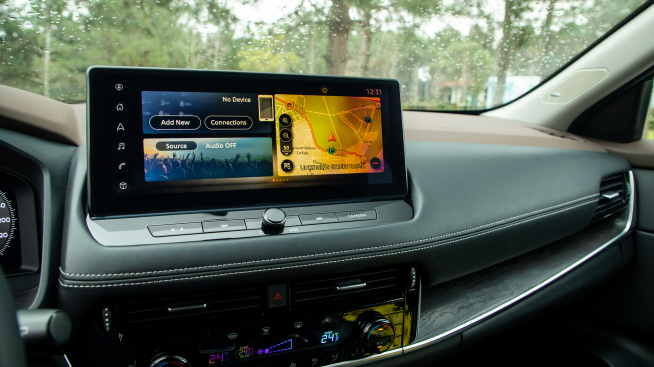Types of trucks, explained

“Keep on trucking” is more than just a fun catchphrase printed on hats and t-shirts — the breadth of the modern truck market shows truck enthusiasts are living up to those words. Just driving around town you’re likely to spot several different types of trucks, from huge industrial trucks all the way down to the light pickup truck in someone’s driveway. Let's get to know them a little bit better.
Truck vs. car: What’s the difference?
The biggest difference between trucks and cars is intended usage. Cars are intended primarily for transporting passengers. Trucks are designed to transport passengers too, but they have an additional (and sometimes primary) focus on hauling and towing cargo. This intended difference in how they’re used also leads to different frame construction styles on trucks. Trucks often have a “body-on-frame" construction as opposed to the “unibody” construction of most passenger cars.
Unibody construction features a chassis (base frame) and body frame that’s fabricated as a single, cage-like unit. This style is sometimes referred to as “monocoque,” after the French term for “single-shell.” Unibody construction has greater overall structural rigidity, which can be helpful for passenger safety.
Body-on-frame construction, on the other hand, has a body frame made up of several components constructed on top of a separate chassis. This allows for greater flexibility under torsion: twisting force your truck experiences while off-roading or hauling weight. This construction also typically results in a vehicle that’s bulkier and heavier.
Weight classes of trucks
In the U.S., trucks are categorized into eight distinct classes of vehicles based on their gross vehicle weight rating (GVWR). This is the maximum weight the truck can function under, including the truck itself, cargo and trailers. The higher the GVWR, the higher the truck’s functioning weight capacity.
Class 1
- GVWR: 0–6,000 pounds
- Description: The lightest of all truck types, Class 1 vehicles are popular among consumers for non-commercial use — think something like your average pick-up truck.
Class 2
- GVWR: 6,001–10,000 pounds
- Description: Class 2 vehicles are a little heavier and include many popular full-size pickup truck models intended mostly for consumer use and some light commercial use.
Class 3
- GVWR: 10,001–14,000 pounds
- Description: Class 3 vehicles are heavier consumer trucks and pickups, often used in commercial work. Some heavy duty pickups will fall under this class.
Class 4
- GVWR: 14,001–16,000 pounds
- Description: Class 4 vehicles are where the focus on function and commercial use becomes much more prominent. Examples include box trucks or delivery trucks, the kind your local grocery store might use.
Class 5
- GVWR: 16,001–19,500 pounds
- Description: Class 5 vehicles include bucket trucks and farming trucks. Your local electric company likely has a fleet of Class 5 bucket trucks.
Class 6
- GVWR: 19,501–26,000 pounds
- Description: These require a special license to drive. Class 6 vehicles include things like beverage trucks and school buses.
Class 7
- GVWR: 26,001–33,000 pounds
- Description: Class 7 trucks are some of the behemoth-style trucks you likely see around town. They’re commonly deployed as street sweepers, garbage trucks and transit buses.
Class 8
- GVWR: Above 33,000 pounds
- Description: These are the real whoppers, the massive 18-wheeler trucks you see rolling down the highway carrying cargo across the country.
Truck duty classifications
While GVWR is one way to classify the different types of trucks, they can also be categorized based on the type of work, or duty, that they’re best suited for.
Light-duty trucks
Light-duty trucks, sometimes just called “light trucks,” are trucks that fall in GVWR Classes 1, 2 and 3.
Medium-duty trucks
Medium-duty trucks consist of trucks within GVWR Classes 4, 5 and 6.
Heavy-duty trucks
Heavy-duty trucks are Class 7 and above.
Considerations for consumers
When looking at a potential truck you’re thinking of buying, it helps to be aware of a few additional considerations beyond its weight class and duty.
Curb weight and payload capacity
As you recall, GVWR is the maximum weight of a truck including any potential trailers and cargo. This isn’t what the truck itself actually weighs when it comes off the factory line though — that's the “curb weight.” Curb weight is the weight of just the vehicle with a full tank of gas, not counting any passengers, non-standard equipment or cargo.
The payload capacity is how much additional weight the truck can carry beyond its curb weight. Essentially, it’s the difference between the truck’s GVWR and its curb weight. When shopping, knowing the difference between curb weight, payload capacity and GVWR can help you assess if the truck meets your needs or not.
Size and handling
While several types of trucks don’t require any special licensing to drive, they can still take some getting used to. The saying “it drives like a truck” exists for a reason — trucks are built differently and that contributes to a slightly different driving experience. For many consumers, light-duty models will typically strike a good balance of size, power and handling.
Fuel economy
Another consideration in selecting the right truck is fuel economy. The size of the engine is not the only thing to consider. Many factors can affect this, such as engine efficiency, vehicle weight, and wheel size. Selecting the truck size that meets your needs can help you achieve better fuel economy.
In summary
Now that you’ve dipped your toes into the different types of trucks, you might be able to appreciate the sentiment "keep on trucking” even more. Trucks aren't your average cars — they're distinguished from cars by functionality and starkly different body construction. When buying a truck, it helps to look beyond its weight and duty rating by considering things like fuel economy and your own intended use for the truck.



